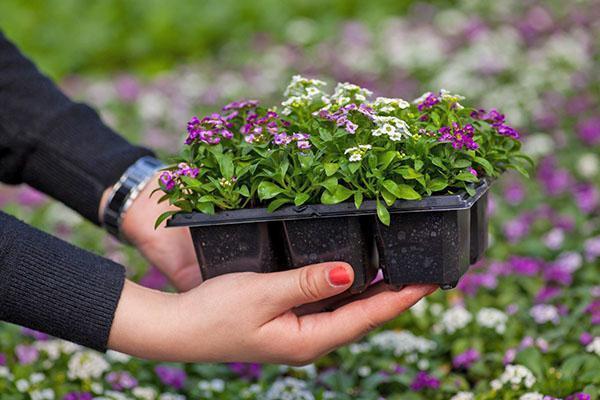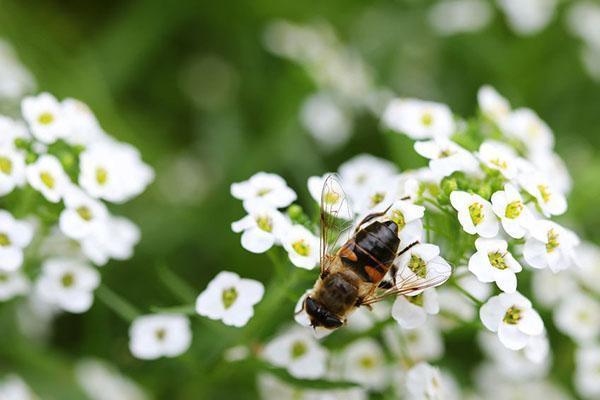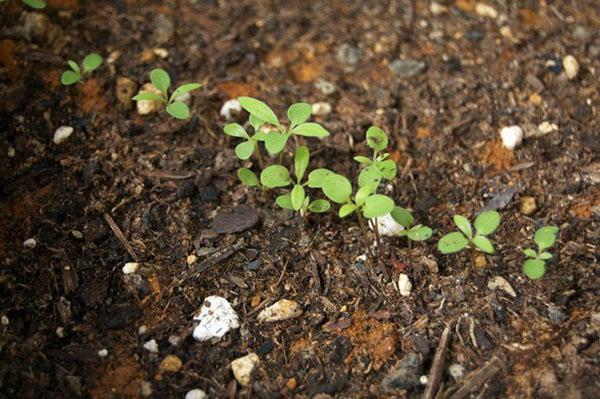Subtleties of planting and care in the open field for annual and perennial alissum
 Alyssum does not, like lilies or garden roses, have lush flowers, but the plant does not cease to acquire more and more new fans. A modest alyssum, planting and caring in open ground for which a beginner can do it, captivates with its unpretentiousness, long flowering and honey aroma spreading over the flower beds.
Alyssum does not, like lilies or garden roses, have lush flowers, but the plant does not cease to acquire more and more new fans. A modest alyssum, planting and caring in open ground for which a beginner can do it, captivates with its unpretentiousness, long flowering and honey aroma spreading over the flower beds.
Several annual and perennial alissum species are used as ornamental plants for open ground. All of them are undersized or creeping crops with stems up to 40 cm, small, sometimes pubescent leaves and flowers of different colors collected in corymbose inflorescences. Since alyssum is a member of the Cabbage family, its corollas up to 5 mm in diameter have a structure in common with related plants, but at the same time are very fragrant.
The smell of flowers intensifies in sunny warm weather, which attracts many pollinating insects that are irreplaceable in the garden to the clumps of alyssum.
As an annual for open ground, alissum is used in the design of low borders, in mixborders and in the foreground of traditional flower bed.

- sowing in the spring immediately to a permanent place;
- through seedlings grown at home and transferred to open ground in spring;
- with the help of autumn sowing in the ground to obtain early spring shoots.
What is the best way to plant alyssum in the ground when planting flowers in a particular climatic zone?
Planting alyssum in open ground with seeds
 Sowing alyssum seeds in spring is carried out when the soil thaws and the air warms up to +15 ° C. In the middle lane, optimal conditions are formed by mid-April. In the southern regions, planting is carried out 7-10 days earlier. In the north, due to the return cold weather, the right moment can be postponed until the first ten days of May.
Sowing alyssum seeds in spring is carried out when the soil thaws and the air warms up to +15 ° C. In the middle lane, optimal conditions are formed by mid-April. In the southern regions, planting is carried out 7-10 days earlier. In the north, due to the return cold weather, the right moment can be postponed until the first ten days of May.
In the spring, planting alyssum in open ground and caring for plants is preceded by site selection and soil preparation. Both annual and perennial species prefer dry, without stagnant water, aerated places with a light substrate:
- Before sowing, the soil is rolled, removing weeds and breaking clods.
- The area allocated for the alissum is watered.
- Seeds are spread over the surface of the substrate and lightly sprinkled with a layer of earth.
To guarantee germination and simplify care after planting in the ground in Siberia, alyssum is covered with a film or non-woven material before sprouts appear. Young plants appear in flower beds after 7-10 days, and after another 6-8 weeks flowering begins. Until this moment, the site is regularly weeded and watered, and the mature seedlings are thinned out, leaving an interval of 15–20 cm between them.
This method of planting alyssum is simple. But if the spring is protracted, the emergence of seedlings and flowers is delayed. In regions where there is such a risk, including the middle lane, planting seedlings is more often used.
Alyssum seedlings: planting and care in the open field
 Sowing for seedlings is carried out in March or April in shallow containers filled with a light substrate. The soil is preliminarily slightly moistened, and the seeds distributed over the surface and slightly pressed into the soil are covered with a thin layer of soil or sand.
Sowing for seedlings is carried out in March or April in shallow containers filled with a light substrate. The soil is preliminarily slightly moistened, and the seeds distributed over the surface and slightly pressed into the soil are covered with a thin layer of soil or sand.
Alyssum grows better at temperatures above +15 ° C, in a greenhouse or home greenhouse, while the seedlings must be ventilated to prevent condensation.
Seedlings appear in less than 2 weeks. Until then, the container is placed in a well-lit area If the seedlings are planted densely, the seedlings dive. And when several real leaves open on them, they pinch the top so that the alissum in the flower bed actively bush. Alyssum planting for outdoor care is carried out in May or in the first half of June with an interval of about 20 cm.
 Already after 2-3 weeks, such plants bloom and, with proper care, do not lose their decorative effect until the very frost.
Already after 2-3 weeks, such plants bloom and, with proper care, do not lose their decorative effect until the very frost.
Planting alyssum in open ground in autumn
 The pre-winter sowing of alyssum allows in natural conditions to carry out the stratification of seeds and in the spring to get strong plants adapted to the conditions of open ground.
The pre-winter sowing of alyssum allows in natural conditions to carry out the stratification of seeds and in the spring to get strong plants adapted to the conditions of open ground.
Stratification increases germination, which is important when growing perennial plant varieties. Planting alyssum in open ground in the fall is carried out so that the seeds do not have time to swell and hatch. Therefore, it is planned for the end of October or November. Dry seeds are buried in pre-prepared soil to a depth of about 2 cm.
To protect the seed from rotting, a sand cushion can be made at the bottom of the furrow. On top of the plot is mulched.
Alyssum care after planting in the open field
 Alyssum belongs to the most unpretentious plants, content with minimal care. Annual and perennial varieties bloom excellently in open areas, spending many hours in the sun. In this case, caring for alyssum in the open field after planting consists of:
Alyssum belongs to the most unpretentious plants, content with minimal care. Annual and perennial varieties bloom excellently in open areas, spending many hours in the sun. In this case, caring for alyssum in the open field after planting consists of:
- in irrigation, providing soil moisture to a depth of at least 10-15 cm;
- in weeding and loosening the soil around flowers;
- in 2-3 times plant feeding mineral mixtures with a minimum nitrogen content, causing the growth of greenery and reducing the intensity of flowering;
- in the removal of wilted inflorescences.
When flowering is over, the agrotechnics for perennials and summer plants begin to differ.
Annual alissums are removed from the flower bed, the site is cleaned of plant residues and dug up. If this is not done, the seed pods will open, and in the spring the summer resident will face massive self-seeding.
 When a perennial plant was planted on the site, care in the open ground for alyssum is:
When a perennial plant was planted on the site, care in the open ground for alyssum is:
- in clipping curtains, involving the removal of dried inflorescences and pruning of shoots by more than half;
- in pre-winter weeding and loosening of the soil;
- in the protection of shrubs from frost.
Fallen leaves, needles or dense non-woven material can serve as a shelter for the winter. The vein is removed, the plantings are sanitized. Plants are watered and fed.